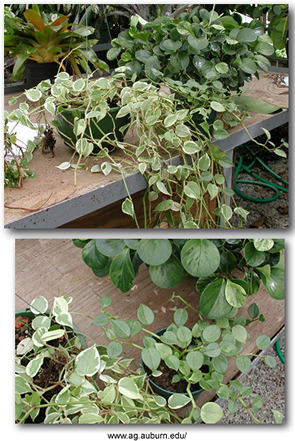Rubber Plants (Ficus elastica)

Plants that Detoxify the Air
The Rubber Plant (Ficus elastica) has been bred for toughness. It will survive in less light than most plant of its size. It will tolerate dim light and cool temperatures.It receives high marks in all categories and is an excellent overall houseplant. This plant can be kept best in semi-sun to semi-shade.
Effective Remover of Air Pollutants:
Of the ficus plants tested to date, the rubber plant is the best for removing chemical toxins from the indoor environment, especially formaldehyde. Its ability to remove air pollutants and its excellent performance in all categories make it a most valuable houseplant.
Safety Around Pets:
Toxic Principle: Leaves may be toxic, Low toxicity, Toxic alkaloids possible
(Ref.: OSU Center for Veternary Health Sciences)
Rubber Plants
Prepared by Marjan Kluepfel, HGIC Information Specialist, and Bob Polomski, Extension Consumer Horticulturist, Clemson University - Original Article
Rubber plants (Ficus elastica) are easy to grow and care for and do well in a variety of conditions. They are excellent plants for beginners.
Height / Spread
Rubber trees can easily grow 6 to 10 feet tall or more indoors if there is enough space. They can be pruned to reduce their size.
Ornamental Features
Rubber trees are grown for their glossy, leathery, large leaves. The leaves are oblong to oval, 8 to 12 inches long and in various colors of dark green, deep maroon or marked with yellow, cream, pink or white.
Culture
Rubber plants prefer bright light but are adaptable to low light. They grow best with the morning light from an east window. They do well in warm to average room temperatures. The ideal temperatures are 60 to 65 ° F at night and 75 to 80 ° F during the day.
Water rubber trees thoroughly, but let the soil dry somewhat between waterings. The soil mix should be a well-drained houseplant mix. Rubber trees prefer humid conditions, but tolerate the dry air common in homes.
Fertilize regularly with a water-soluble houseplant fertilizer during active growth. Plants that are in lower light should be fertilized less often.
Rubber trees may grow tall and lanky indoors. You can support them with a stake or prune them in spring to rejuvenate. Propagate new plants by stem or tip cuttings or air layering. Repot in late winter or early spring if needed.
Wash the leaves with water when they get dusty to keep them attractive and help your plant stay healthy.
Problems
In the home, plant diseases are very rarely a problem. Too much or too little water plus insects and mites are the main problems. Root rot usually results from a soil mix that does not drain quickly or overly frequent watering.
Leaf yellowing may occur if the soil stays too wet. Too little light, dry air or cold drafts may cause leaf loss. Mealybugs may infest rubber plants.
The sticky white sap may irritate skin or the stomach if eaten. Keep these plants away from any pets or young children that tend to eat plants.
Cultivars
-
- ‘Decora’ is a widely available cultivar with dark leaves with creamy white midribs.
- ‘Doescheri’ has cream and gray variegated leaves with pink ribs.
- ‘Foliis Aureo-marginata’ has gold margined leaves.
- ‘Robusta’ has very large leaves up to 18 inches long. It is good in low light.
- ‘Rubra’ has leaves that are reddish when young and mature deep green with red edges.
- ‘Tricolor’ has green leaves with cream and pink patches.
Prepared by Karen Russ, HGIC Information Specialist, and Bob Polomski, Extension Consumer Horticulturist, Clemson University
This information is supplied with the understanding that no discrimination is intended and no endorsement by the Clemson University Cooperative Extension Service is implied. Common names of pesticides are given as a convenience and are neither an endorsement nor guarantee of the product nor a suggestion that similar products are not effective. Use pesticides only according to directions on the label. Follow all directions, precautions and restrictions that are listed. (New, 9/99)
The Clemson University Cooperative Extension Service
offers its programs to people of all ages, regardless of race, color, sex, religion, national origin, disability, political beliefs, sexual orientation, marital or family status and is an equal opportunity employer.
Clemson University Cooperating with U.S. Department of Agriculture, South Carolina Counties, Extension Service, Clemson, South Carolina. Issued in Furtherance of Cooperative Extension Work in Agriculture and Home Economics, Acts of May 8 and June 30, 1914
Public Service Activities
GreenAndHealthy.Info strives to maintain accurate and up-to-date information; however, mistakes do happen. If you would like to correct or update any of the information, please send us an e-mail. THANK YOU!

